The Perfection of Renunciation
Text by Karunasindhu dasa
High In The Himalayan Mountains, a naked yogi sits in a cave, on a deerskin, meditating on the Supreme Truth. He eats nothing, sees no one and goes nowhere, for he is practicing renunciation of the material world.
In an entirely different setting, in Los Angeles, California, a community of three hundred Hare Krishna devotees lives in a suburban neighborhood sometimes called the “Hare Krishna quarter,” which includes a dozen offices, four apartment buildings, a book warehouse, a stately temple and a large factory. Men and women, many with young children, they dance, sing, eat sumptuously, work hard and handle large sums of money—yet surprisingly enough, they also claim to practice renunciation of the material world. Even more astounding, if we examine the positions of the recluse meditator and the society of devotees, we find that according to the Vedic scriptures the lives of the Krishna conscious devotees are more renounced, for everything the devotees do is for the satisfaction of Krishna, the Supreme Personality of Godhead.
 While taking a tour of the Los Angeles community (which, for its opulence, he named “New Dvaraka” after Lord Krishna’s celestial capital city on earth), Srila Prabhupada, the spiritual master of the Hare Krishna movement, once recited this verse from the Vedic scriptures:
While taking a tour of the Los Angeles community (which, for its opulence, he named “New Dvaraka” after Lord Krishna’s celestial capital city on earth), Srila Prabhupada, the spiritual master of the Hare Krishna movement, once recited this verse from the Vedic scriptures:
anasaktasya visayan
yatharham upayunjatah
nirbandhah Krishna-sambandhe
yuktam vairagyam ucyate
prapancikataya buddhya
hari-sambandhi-vastunah
mumuksubhih parityago
vairagyam phalgu kathyate
“When one is not attached to anything but at the same time accepts everything in relation to Krishna, one is rightly situated above possessiveness. On the other hand, one who rejects everything, without knowledge of its relationship to Krishna, is not as complete in his renunciation.” {Bhakti-rasamrta-sindhu, 1.2.255-256) Srila Prabhupada asked that this quote be written on a sign and hung in a prominent place in the temple, for it pinpoints the essence of the Los Angeles temple’s spiritual success: that all its activities and paraphernalia are directed not for anyone’s selfish sense gratification but for the transcendental pleasure of the Supreme Lord, Sri Krishna.
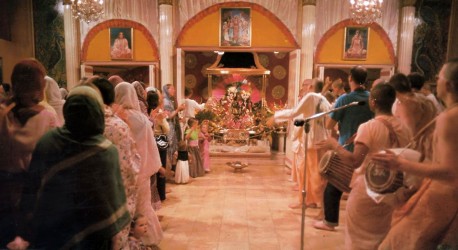
Temple Worship
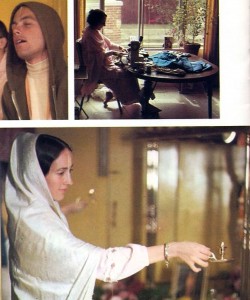
The entire Los Angeles community of devotees gathers for kirtana (congregational chanting of the names of God) at 4:30 every morning. According to Vedic scriptures, to rise one and a half hours before sunrise and attend the kirtana ceremony starts the day with potent spiritual inspiration. Men on one side, women on the other, in two rows the length of the temple, the devotees face the three closed doors that house the holy Deities. The women wear saris; the men, dhotis (robes)—white if they are married, saffron if they’re not. Both men and women wear white clay tilaka marks on their foreheads, signifying that they are devotees of Krishna.
The chanting of Hare Krishna begins, accompanied by hand cymbals and drums. After a few minutes of chanting, the pujari (altar attendant) rings a bell and then opens the three large doors, revealing the Deities, chief of whom are Radha and Krishna.
The pujari then offers the Deities a flame, handkerchief, conch shell and other articles one after another in large circles, as the chanting of Hare Krishna increases its tempo, the devotees swaying rhythmically from side to side, a few small children dancing with their parents. On the marble altars, artfully arranged with flowers, vases and candles, three silver trays of milk and sweets present the first of six daily offerings to the Deities, who are dressed in silks and ornaments. Singing and dancing, the devotees worship with rapt attention. But, one might ask, who are the Deities?
Srila Prabhupada has clearly explained the Deity worship in his books and lectures. “You cannot approach or see Krishna with your present blunt senses and contaminated desires,” he writes. “But Krishna is so merciful that He appears before you in the form of the Deity so that you may see Him and render loving service. Everything is Krishna’s energy, and so He can appear in this form if He likes.”
The form of Krishna in the temple with Radharani, His eternal consort and pleasure energy, is not a mere idol fashioned from imagination, nor is the worship in the temple a whimsical or concocted process. The Vedic scriptures describe in detail the Lord’s form and how to carve or paint the form of the Deity. Since the Supreme Lord is absolute, His form is not different from Him. Thus the form of the Lord in the temple is an authorized incarnation of the Lord who can accept the loving service of His devotees.
Srila Prabhupada often gives the example of a mailbox. The post office establishes boxes for the deposit of mail, and because these boxes are authorized, putting mail in the box is as good as putting it in the post office itself. Similarly, because the Vedic scriptures authorize the form of the Lord in the temple as a fully potent incarnation of the Lord, to worship the Deity in the temple is to worship the Supreme Personality of Godhead Himself.
This facility to worship the Lord’s form is a great benediction because it enables one to serve the Lord in a personal way and fix one’s mind upon the Lord’s personal features. The vital principle of Deity worship is to fix one’s mind upon the form of the Lord and consider oneself His humble servant.
In this consciousness, the devotees in New Dvaraka consider themselves humble servants of the Deity. Thinking of Him as the owner and controller of everything, the devotees depend upon His mercy and act only to please Him. By centering all their activities around Krishna in this way, the devotees create the blissful spiritual atmosphere of devotional service that is the essence of New Dvaraka.
New Dvaraka’s Distribution of Krishna Consciousness
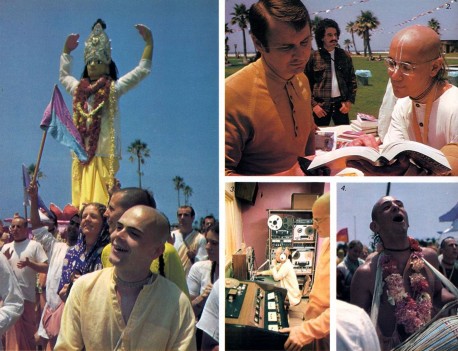
Worship is not confined to the temple. Since the Supreme Lord is all-pervading, His devotees go everywhere to preach His glories for the benefit of those who have forgotten Him. Although New Dvaraka sponsors presentations of Krishna consciousness in high schools and colleges in the Los Angeles area and also holds daily classes and a Sunday festival at the temple, its most important programs for spreading Krishna consciousness are sankirtana and the distribution of Krishna conscious books.
The most visible of the temple’s activities is sankirtana, the public congregational chanting of the holy name of God, as in the Hare Krishna maha-mantra—Hare Krishna, Hare Krishna, Krishna Krishna, Hare Hare/ Hare Rama, Hare Rama, Rama Rama, Hare Hare. The Vedic scriptures recommend this chanting as the most effective means for spreading spiritual consciousness in the modern age. The Garuda Purana gives the following comparison: “The state of conditioned life in the material world is like the unconsciousness of a man bitten by a snake, for both these unconscious states can be ended by the sound of a mantra.”
Commenting on this verse, our spiritual master explains: “When a man is snake-bitten he does not die immediately, but first becomes unconscious and remains in a comatose condition. Anyone who is in the material world is also sleeping, as he is ignorant of his actual self or his actual duty and his relationship with God. So materialistic life means that one is bitten by the snake of maya, illusion, and thus, without Krishna consciousness, he is almost dead. Now the so-called dead man bitten by a snake can be brought back again to life by the chanting of some mantra. There are expert chanters of these mantras who can perform this feat. Similarly, one can be brought back into Krishna consciousness from the deadly unconscious state of material life by hearing of the maha-mantra: Hare Krishna, Hare Krishna, Krishna Krishna, Hare Hare/Hare Rama, Hare Rama, Rama Rama, Hare Hare.”
Understanding the potency of the maha-mantra, new Dvaraka’s devotees go to the busiest areas of Los Angeles to spread this benediction. As their other duties allow, some devotees go out chanting once a week, some once a day, and some every day, all day long. This chanting not only purifies those who chant but also those who hear, be they conscious of its potency or not. Thus one who hears the maha-mantra gradually becomes eligible to understand Krishna consciousness and engage in the devotional service of Lord Krishna.
Since the background for this chanting is a uniquely detailed, clear, scientific and therefore convincing philosophy of spiritual consciousness, the Hare Krishna devotees understand that their most effective preaching is the distribution of their spiritual master’s books, which convey this philosophy as originally enunciated by the Supreme Lord Krishna Himself.
New Dvaraka distributes Krishna conscious books not only locally but on a nationwide level, for devotees in New Dvaraka arrange the shipment of books to other Krishna conscious centers throughout the United States. According to the devotees who manage New Dvaraka’s book warehouse, last year the warehouse served as a distribution center for five hundred tons of books. New Dvaraka is also the distribution center for Back to Godhead, which now has a monthly circulation of almost half a million copies. The money collected on sales of books and magazines goes for printing more, and thus the distribution is always increasing.
Locally, devotees distribute Krishna conscious literature personally, hand to hand, to interested readers. The chanting party distributes many books, and other devotees, who go out individually with big bags full of books, distribute many more. According to Ramesvara dasa, one of the chief architects of New Dvaraka’s book distribution program, “These book distributors are the greatest friends of mankind because they are dedicated to spreading knowledge and giving relief and the joyful life everyone is seeking. They don’t take vacations; they are always thinking of how to distribute this knowledge.”
Some devotees are so eager to distribute Krishna conscious books that they do it all day long. Tripurari dasa, one of New Dvaraka’s most enthusiastic distributors, explains: “Every time I give someone a book, I feel that I’ve pleased my spiritual master. Prabhupada came here to distribute this science of Krishna consciousness to everyone, and the duty of the disciple is to serve and assist the spiritual master. By pleasing God’s devotees one can please God. So when I try to help the mission-of my spiritual master, I know I have pleased Krishna too. Whoever gets a book gets the highest knowledge, and he can be really joyful.”
Adding still another dimension to New Dvaraka’s programs, Golden Avatar Productions makes the philosophy and chanting of the Krishna consciousness movement available on the radio, on records and on tape cassettes. Started two years ago by Krishnakanti dasa, an electronics engineer who worked for six years with NBC television before joining the New Dvaraka community, Golden Avatar has distributed more than 25,000 tape cassettes and produces a weekly radio show, broadcast by eighty stations throughout the United States.
Brahmacaris
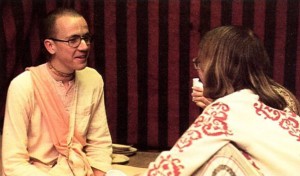
Everyone in New Dvaraka serves Krishna, but how each devotee does so depends upon his skills and leanings and also upon his social status. A Vedic community divides its members into four social groups: brahmacaris (students), grhastha (householders), vanaprastha (the retired) and sannyasis (the renounced). Each of these groups has different duties.
Since the duty of a vanaprastha-a married man who wishes to develop detachment and retire from family life-is to travel for purification, and the duty of a sannyasi-a renounced ascetic-is to travel and preach, there are no vanaprasthas and sannyasis in residence at New Dvaraka; all the devotees are brahmacaris and grhasthas.
The brahmacaris are unmarried Krishna conscious students. The Vedic culture does not allow an unmarried boy to dally in sexual affairs, for such intrigues simply create agitation, both for oneself and for others, and thus stand in the way of spiritual progress. According to the Vedic system, one who feels a need for the companionship of a woman should marry and live as a peaceful and responsible gentleman, and one who does not feel such a need should forget about sex altogether and concentrate his energy in Krishna consciousness.
Brahmacari life, therefore, is a life of freedom from sex-and the entanglements that come with it. A brahmacari need not worry about how to get food, money, a home and security to keep a wife and family happy. He keeps only the bare necessities of life (which Krishna provides very easily), and he can go anywhere at a moment’s notice. Thus brahmacari life is simple and carefree.
Since a brahmacari can engage full time in cultivating Krishna consciousness for his own spiritual advancement and spreading it for the benefit of others, the brahmacaris constitute New Dvaraka’s main preaching force. Most of the book distributors and members of the chanting party are brahmacaris, like Ramesvara and Tripurari. New Dvaraka also has two groups of three brahmacaris who travel all around the United States in vans, distributing Krishna conscious books and telling people about Krishna. They take great pleasure in traveling and preaching.
The brahmacaris who are not out on the road live in the main temple building at New Dvaraka. (The unmarried girls live in similar quarters across the street, and married couples live in apartments in the neighborhood.) Living and working together in Krishna consciousness, the brahmacaris form a closely knit family of Godbrothers. “This is an ideal life for spiritual advancement,” says Gopavrndapala dasa, the brahmacari who serves as New Dvaraka’s temple coordinator, organizing the temple’s daily routine work. “Some people may think brahmacari life very austere and dry, but actually it is full of nectar.” Gopavrndapala, twenty-three years old, was born in California. He lived in various yoga communes prior to joining the Krishna consciousness movement. “Because of the powerful cleansing effect and the joy of the chanting,” he says, “I was curious to learn more about the philosophy.” Since he was unmarried and wanted to join the temple, he became a brahmacari at New Dvaraka. “We do not give up anything through artificial repression,” he notes. “But we get more enjoyment from serving Krishna than from material life. One can stay a brahmacdn if he likes, or one can marry. The main thing is to become Krishna conscious.”
Householder Life in New Dvaraka
According to the strict rules of most genuine yoga systems, including hatha-yoga, jnana-yoga and sankhya-yoga, women are not allowed to participate, and men must renounce all family ties. But bhakti-yoga, Krishna consciousness, is so powerful in its purification that its full benefits are available to renounced celibates and to married men and women as well.
“The Vedic scriptures,” Srila Prabhupada explains, “describe two kinds of householders: grhasthas and grhamedhis. A grhastha is a married man who lives with wife and children, but transcendentally-to realize the Supreme Truth. Grhamedhis, however, live only for their families and friends; they are envious of others. Please do not be a grhamedhi.” Disregarding spiritual culture, grhamedhis spend their days either making money or spending it, and their nights they spend sleeping or enjoying sex. They depend upon their families, friends, communities and nations, not realizing that these are armies of fallible soldiers who cannot protect them from death. Thus the grhamedhis, in the final issue, are failures, because they die without realizing the ultimate goal of life.
A Krishna conscious householder is a grhastha who lives for transcendental progress, not for envious competition with others for artificial opulence. Most of New Dvaraka’s married couples live in comfortable apartments in four nearby buildings owned by the Society, but their lives revolve as much around the temple as around their homes, for the center of their lives is Krishna. Since marriage affords a less austere, physically more comfortable existence than the life of a brahmacari, some devotees find it easier to make Krishna conscious progress in marriage than in brahmacari life. In return for the pleasures of being a house holder, a married man takes the responsibility for both the spiritual welfare and material comfort of his family. Thus New Dvaraka’s householders all work at paying jobs-some within the New Dvaraka community, others outside. Generally the men who work outside give half of their income to supporting the temple’s programs.
In Krishna consciousness, husband and wife assist each other in serving Krishna, and they raise children in bhakti-yoga. Susarma dasi, a married girl at New Dvaraka, says, “Our children, five years old and two years old, are automatically learning spiritual principles, and this is one big thing that drew us here. We were trying to do meditation and yoga, and it always had to be when the children were asleep. We couldn’t include them in it. But even a child can chant Hare Krishna.”
“This is a practical spiritual community,” comments Umapati dasa, a 36-year-old householder who has settled in New Dvaraka with his wife, Ilavati, and who works as a computer programmer for New Dvaraka’s Spiritual Sky Scented Products Company. “Regardless of one’s occupation or social position, anyone can engage in Krishna consciousness and achieve the highest perfection of life.”

Spiritual Sky
“By the way you are managing this business,” stated a letter from Srila Prabhupada to Jayatirtha dasa Adhikari, President of the Spiritual Sky Scented Products Company, “I can understand that you are completely surrendering to Krishna.” Spiritual Sky, whose headquarters are also a part of the Los Angeles Krishna conscious community, is a commercial enterprise organized by the Krishna consciousness movement to gather funds for use in spreading Krishna consciousness.

Spiritual Sky is growing quickly, having doubled its size each year for the past four years and looking to double it again in the coming year. The company markets and manufactures incense, oils, shampoo, soap and other scented products. “It may seem contradictory or hard to understand that we are engaged in business dealings but still act on the spiritual platform,” says Jayatirtha, the company’s slender 24-year-old president. “But it’s simply a matter of whose account you are working for. We are working for Krishna. The revenue from this business is not accumulating in someone’s bank account or being used to buy big, luxurious houses or something like that. Everyone works here as a volunteer, and their incidental expenses for living are provided. We all live simply, and it works nicely.”
“We’re not bound up by any of this work,” explains Ranadhira dasa, the company’s marketing vice-president. “Krishna assures us in Bhagavad-gita that anyone who surrenders the fruits of his labors to Him is free from implication in materialistic life. That’s the secret of Krishna consciousness: work done for Krishna’s pleasure.” He elaborates further: “Of course, that’s not a whimsical principle. We are taking guidance from our spiritual master and scripture. You can’t concoct away for serving God and pleasing Him just by doing anything that pleases you and saying it pleases Him. On the other hand, the process isn’t dry; since Krishna is the Supreme and we’re His parts and parcels, our pleasure is included in Krishna’s pleasure.”
Jayatirtha notes that although Spiritual Sky may appear just like any other enterprise, there are two fundamental differences. The first is that the Company uses its profits only to spread the teachings of Krishna consciousness, and the second is that the mentality of the staff is transcendental, for it is fixed upon Krishna, the Supreme Personality of Godhead.
“We are practical spiritualists,” says Jayatirtha. “Funds and organization are useful-even jet aircraft and technology can be useful if employed properly. We do not deny these things by artificially renouncing them; we simply use them for advancing spiritual understanding.”
The Spiritual Master
 The devotees are confident about taking on so many apparently worldly activities in New Dvaraka because all these activities are authorized by a bona fide spiritual master, His Divine Grace A.C. Bhaktivedanta Swami Prabhupada. One cannot take on any spiritual activity by one’s whimsical concoction. One must receive guidance from a bona fide spiritual master.
The devotees are confident about taking on so many apparently worldly activities in New Dvaraka because all these activities are authorized by a bona fide spiritual master, His Divine Grace A.C. Bhaktivedanta Swami Prabhupada. One cannot take on any spiritual activity by one’s whimsical concoction. One must receive guidance from a bona fide spiritual master.
All the programs in New Dvaraka-from temple worship, to book distribution, to the operation of Spiritual Sky-take place under Srila Prabhupada’s sanction. The essence of Krishna consciousness is “always to remember Krishna and never to forget Krishna.” The spiritual master engages his disciples in such a way that they may always be able to think of the Supreme Lord while engaged in their various duties.
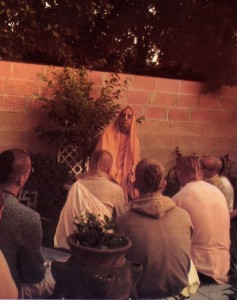 Srila Prabhupada travels all over the world, preaching in Nairobi, London, Paris, Sydney, Tokyo, Bombay, Mexico City, and all over the United States, but he spends at least three months a year in New Dvaraka, where he is able to concentrate on translating the Vedic scriptures into English.
Srila Prabhupada travels all over the world, preaching in Nairobi, London, Paris, Sydney, Tokyo, Bombay, Mexico City, and all over the United States, but he spends at least three months a year in New Dvaraka, where he is able to concentrate on translating the Vedic scriptures into English.
In Los Angeles, Srila Prabhupada rises early and goes on a morning walk in a nearby park or at Venice Beach by the Pacific Ocean, all the while speaking to his disciples about Krishna conscious philosophy. Then he comes back to give the morning class to the devotees in the temple from an elevated seat called the vyasasana. (Vyasasana literally means “the seat of Vyasa,” Vyasa being the incarnation of Krishna who originally compiled all the Vedic literature. A bona fide spiritual master must follow in the footsteps of Vyasa, always glorifying Krishna according to the conclusions of the Vedic literature.) From the vyasasana, Srila Prabhupada speaks about the science of God, leads the devotees in chanting and worshiping the Deity, and, on behalf of Krishna, accepts the devotees’ service, as a viceroy accepts honor on behalf of a king. The spiritual master never considers himself God or accepts service on his own behalf; he only accepts service on behalf of the Supreme Lord.
In the building next to the temple are Srila Prabhupada’s quarters, where he composes his books on a dictaphone. Working at night, he has produced more than a dozen important books in this way. The devotees of New Dvaraka have also made a walled garden for Srila Prabhupada that he has declared one of his favorite places in the world.
Even when Srila Prabhupada is traveling in another part of the world, however, he is present in his instructions. He has told the devotees that if they always chant the Hare Krishna mantra and serve Krishna sincerely through New Dvaraka’s many programs, they will become completely purified and go back home, back to Godhead.
Conclusion
New Dvaraka, then, demonstrates the perfection of renunciation, for the devotees there see everything as Krishna’s energy and engage everything in His loving service. New Dvaraka is growing because its residents are following in the footsteps of the denizens of the original Dvaraka by serving Krishna in pure devotion. Of course, Krishna’s own celestial city is opulent beyond comparison. The Vedic scriptures state, for example, that the residents there enjoy eternal youth and beauty, like Krishna Himself, and that brilliant jewels illuminate its palace walls, making electricity unnecessary. New Dvaraka’s working facilities are on a scale more recognizable to this world, but its real opulence-for which you will not be able to find a match even if you travel all over the world-lies in transcendental knowledge of God. Even the children there realize that Krishna is everything, the cause of all causes, and He is their dearest friend, the topic of their talk and play.
The devotees in New Dvaraka have practical God conscious knowledge because they know how to practice renunciation by doing everything in relation to Krishna. Thus they are dedicated to expanding their activities in the future in all ways-by distributing more books, welcoming more families and brahmacaris, increasing their success in business, and doing everything for Krishna’s pleasure. In return for their endeavors, they do not ask anything of the Lord but that He be pleased to continue engaging them in enthusiastic service to Srila Prabhupada, His pure devotee. Krishna has declared in Bhagavad-gita that devotees who work twenty-four hours a day in His service are very dear to Him and will surely attain Him in His eternal spiritual world. In New Dvaraka—and almost one hundred ISKCON centers like it—the Krishna consciousness movement is successfully demonstrating how to live constantly in the highest spiritual consciousness, Krishna consciousness, while at the same time executing one’s daily duties as a student, businessman or householder. This is an ideal model the entire world can follow.
Karunasindhu dasa, a former fine arts student at the University of Washington, joined the Krishna consciousness movement in 1970. He and his wife have been members of the New Dvaraka community ever since. Their five-year-old daughter is a student at ISKCON’s Gurukula school in Dallas, Texas.
Muralivadana dasa, a graduate of Maryland Institute of Art, also joined the Krishna consciousness movement in 1970. He and his wife are also residents of New Dvaraka.


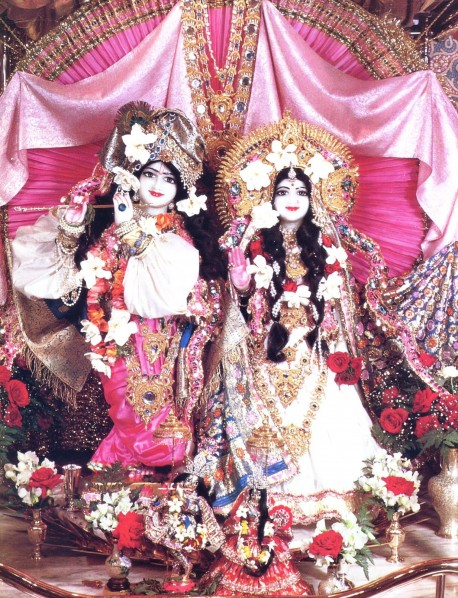
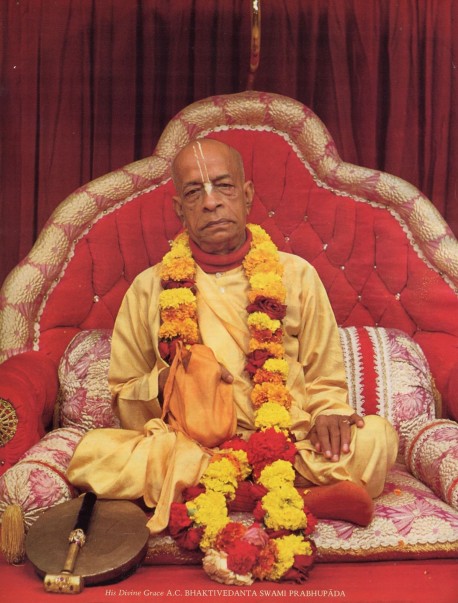
Jaya Jaya Krishna! Jaya Jaya Rama!
It is very happy to know about this commune life Hare Krishna. In this world Commercialism and Materialism You are proving the Essence of Bhagavad Geetha. Very happy to see you. I am quoting your own words.
We are practical spiritualists,” says Jayatirtha. “Funds and organization are useful-even jet aircraft and technology can be useful if employed properly. We do not deny these things by artificially renouncing them; we simply use them for advancing spiritual understanding.”
I met a Hare Krishna gentleman in San Mateo Northern California and saw him again at the San Francisco airport in the mid 70’s . Forgive me for probably not spelling his name correctly but it sounded like ‘ Hooda Hoo Man U’ is he still with you? I believe he moved to Southern California probably 45 years ago.